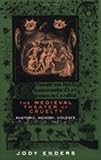The Medieval Theater of Cruelty : Rhetoric, Memory, Violence / Jody Enders.
Material type: TextPublisher: Ithaca, NY : Cornell University Press, [2018]Copyright date: ©2002Description: 1 online resource (288 p.) : 3 halftonesContent type:
TextPublisher: Ithaca, NY : Cornell University Press, [2018]Copyright date: ©2002Description: 1 online resource (288 p.) : 3 halftonesContent type: - 9781501720857
- 809.2/9355 21
- online - DeGruyter
| Item type | Current library | Call number | URL | Status | Notes | Barcode | |
|---|---|---|---|---|---|---|---|
 eBook
eBook
|
Biblioteca "Angelicum" Pont. Univ. S.Tommaso d'Aquino Nuvola online | online - DeGruyter (Browse shelf(Opens below)) | Online access | Not for loan (Accesso limitato) | Accesso per gli utenti autorizzati / Access for authorized users | (dgr)9781501720857 |
Frontmatter -- Contents -- Illustrations -- Preface -- Abbreviations -- A Polemical Introduction -- Chapter 1. The Dramatic Violence of Invention -- Chapter 2. The Memory of Pain -- Chapter 3. The Performance of Violence -- Conclusion: Vicious Cycles -- Works Cited -- Index
restricted access online access with authorization star
http://purl.org/coar/access_right/c_16ec
Why did medieval dramatists weave so many scenes of torture into their plays? Exploring the cultural connections among rhetoric, law, drama, literary creation, and violence, Jody Enders addresses an issue that has long troubled students of the Middle Ages. Theories of rhetoric and law of the time reveal, she points out, that the ideology of torture was a widely accepted means for exploiting such essential elements of the stage and stagecraft as dramatic verisimilitude, pity, fear, and catharsis to fabricate truth. Analyzing the consequences of torture for the history of aesthetics in general and of drama in particular, Enders shows that if the violence embedded in the history of rhetoric is acknowledged, we are better able to understand not only the enduring "theater of cruelty" identified by theorists from Isidore of Seville to Antonin Artaud, but also the continuing modern devotion to the spectacle of pain.
Mode of access: Internet via World Wide Web.
In English.
Description based on online resource; title from PDF title page (publisher's Web site, viewed 26. Apr 2024)


